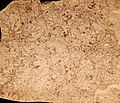Azolla primaeva facts for kids
Quick facts for kids Azolla primaeva |
|
|---|---|
 |
|
| leaves and stems, Klondike Mountain formation | |
| Scientific classification | |
| Genus: |
Azolla
|
| Species: |
primaeva
|
| Synonyms | |
|
Azollophyllum primaevum |
|
Azolla primaeva was an extinct species of "water fern." It lived a very long time ago, during the Eocene epoch, about 50 to 49 million years ago. Scientists found its fossils in southern British Columbia, Canada. This ancient fern is part of the Salviniaceae family, which includes modern water ferns.
Contents
Discovering an Ancient Water Fern
First Finds
The first fossils of Azolla primaeva were found near Princeton, British Columbia. This was in the Similkameen River area. Later, more fossils were found at Stump Lake, also near Princeton.
Naming the New Species
A scientist named David P. Penhallow described these fossils in 1890. He wrote about them in a book about fossil plants from British Columbia. At first, the fossils were not very clear. Because of this, the plant was given a temporary name: Azollophyllum primaevum. This name showed it was similar to modern Azolla ferns. But it also meant scientists weren't fully sure it belonged in the Azolla group.
A Clearer Picture
Years later, new and better fossils were found. These were discovered near a place called Ashnola, British Columbia. This area is about 8 miles south of Princeton. The fossils came from rock layers called the Allenby Formation. Scientists now know these rocks are from the Eocene epoch.
A scientist named Chester A. Arnold from the University of Michigan studied these new fossils. In 1955, he published a paper that officially changed the plant's name. Because the new fossils were so clear, he confirmed it was truly an Azolla species. So, its name became Azolla primaeva.
What the New Fossils Showed
The new fossils showed clear leafy parts and roots. They often formed mats in the rock, just like modern water ferns do. Scientists also found tiny spore cases with the plants. These findings helped confirm its place in the Azolla family.
Azolla Through Time
Other Ancient Azolla
When Azolla primaeva was officially named in 1955, other fossil Azolla species were already known.
- Azolla intertrappea was found in India. It was described in 1934 and was also from the Eocene time.
- Azolla berryi was found in the Green River Formation. This species was also from the Eocene and described in 1934.
- Azolla prisca was found in England. It was from the Oligocene epoch and described in 1926.
- Azolla tertiaria was found in Nevada. It was from the Pliocene epoch and described in 1927.
The Oldest Known Azolla
Even though Azolla primaeva was officially named later, its first description in 1890 actually makes it the earliest Azolla species ever described from the fossil record! This means it was known to science before the others, even if its name changed later.
Comparing Old and New
After studying the new fossils, Arnold noticed that Azolla primaeva looked a lot like a living species called Azolla filiculoides. It also looked similar to A. intertrappea from India. Other Azolla fossils have been found in the Klondike Mountain Formation in Washington. These fossils are from a similar time period, but they haven't been fully described as specific species yet.
Images for kids
-
Fossil mat of A. primaeva Stonerose Interpretive Center


